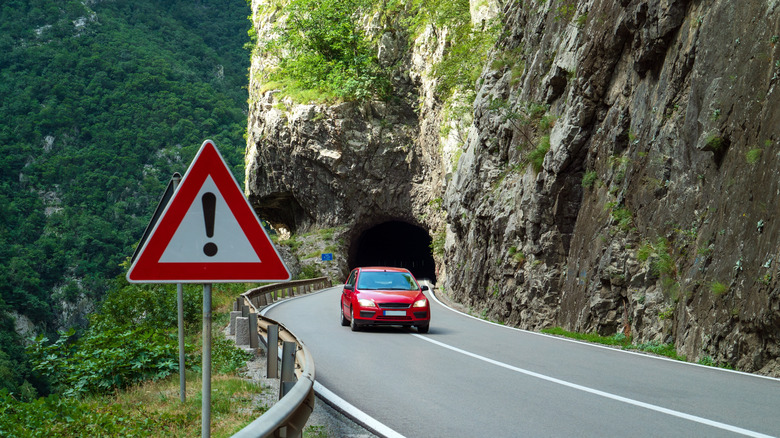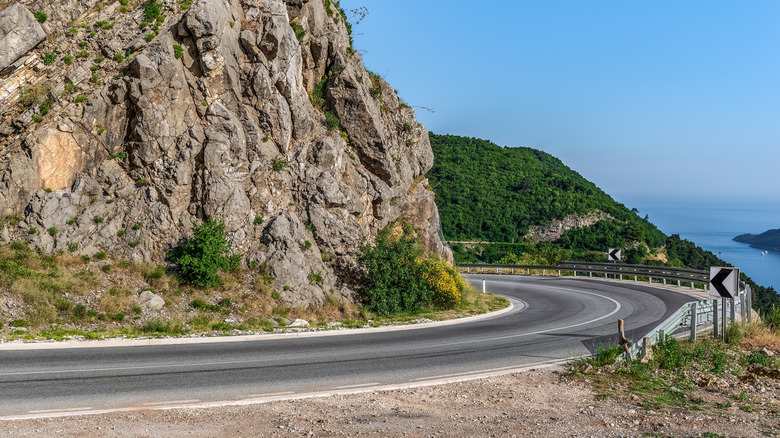Think Twice Before Renting A Car In This Region Of Europe With A Jaw-Dropping Rate Of Traffic Fatalities
Road trips can be one of the best ways to see the world, and Europe is prime for this, with well-connected countries, well-kept roads, and smaller (read also: easier to maneuver) cars. However, when it comes to the European countries that are considered the safest for road trips, the Balkans, unfortunately, do not make the list. (The top safest countries, if you're curious, are Iceland, Norway, the Netherlands, Sweden, and Switzerland). The Balkans — the gorgeous and underrated region of Europe — is home to the European countries with the highest number of highway fatalities, making them the least safe for a road trip.
To the uninitiated, the Balkans is the term for the countries that make up Europe's Balkan Peninsula. While the definition is debated, the region is generally considered to include Albania, Bosnia and Herzegovina, Bulgaria, Croatia, Kosovo, Montenegro, North Macedonia, Romania, Serbia, and Slovenia, encompassing all of what was once Yugoslavia and beyond, and covering much of Central and Eastern Europe (Greece and Turkey also have territories within the Balkan Peninsula, but their inclusion is often debated).
While the collapse of Yugoslavia — not to mention the nearby Soviet Union — opened this region to eager tourists, the scars of the past remain visible. Unfortunately, this is reflected in its high road fatality statistics. So, which countries in the Balkans are the most dangerous for drivers, and why can driving in these countries be so deadly?
Why is it so dangerous to drive in the Balkans?
Vignetteswitzerland.com conducts a yearly study regarding the safety of European roads, and in the years 2022, 2023, and 2024, the Balkan countries of Romania, Serbia, and Bulgaria all ranked as the most dangerous for drivers in Europe. While the region's rugged scenery, with unpredictable roads and weather, certainly contributes to this, it doesn't tell the whole story. After all, Iceland, as mentioned, is among one of the safest countries in the world for road trips, and the Icelandic weather (and landscape) is famously epic.
There are several reasons the Balkans experience such high rates of road fatalities. The main culprit seems to be directly linked to road quality. Years of political instability and war have left much of the region struggling to rebuild. Roads, which require constant upkeep to remain safe, are often neglected in favor of rebuilding other services, especially in more rural areas. Much of the region also consists of mountainous roads that are winding, narrow, and without guardrails. Rural roads through farmland can even be overrun with animals, and while these countries are attempting upkeep, this requires constant road work, another hazard in itself. Another reason for the scary road statistics? The cars themselves. Some locals drive older, rundown vehicles that lack key safety features like headlights and rear lights. Other contributing factors include an overtired populace, long stretches of road with limited options for breaks, and a lack of reliable public transportation, resulting in more cars on the road.
It's worth noting, however, that Slovenia, home to a central European road trip that wraps seven fairytale castles into one awe-inspiring route, is among the safer countries on the list when it comes to driving in the Balkans.
A hopeful trend in the Balkans
Despite the Balkans' reputation for being dangerous for road trips, there is one encouraging trend: Traffic fatalities in each of these countries have declined over the past decade. For example, in 2013, Romania saw around 93 deaths per 1 million residents, per Vignetteswitzerland.com data. By 2022, the number had decreased to 85.81 deaths per million, a full 10.26% decrease. As this was repeated across the board, driving in the Balkans appears to be getting safer. With improved roads and safer cars, these numbers are likely to continue to keep declining — or so we hope. On one border road between North Macedonia and Serbia, for example, the local safety councils launched a "Drive Rested" campaign in 2023. Following the initiative, the busy and dangerous corridor between these two countries saw a 37% reduction in traffic fatalities in just the summer season, the Serbian Traffic Safety Agency told Radio Slobodna Evropa. Fingers crossed that this tragic trend continues to reverse.
If you must drive in the Balkans, though, the key is to be prepared and drive defensively. Use a reliable car with all the necessary safety features, and never drive while tired. Stick to the posted speed limit and religiously follow road signs and lights — no matter what your fellow drivers are doing. These steps can go a long way toward ensuring your safety on those wild Balkan roads.
Still, you may want to wait a few years for that great Balkans road trip. In the meantime, visit this truly incredible region in other ways, like on the Peaks of the Balkans, a long-distance, cross-border trail that lets you hike between Albania, Kosovo, and Montenegro (and more).


